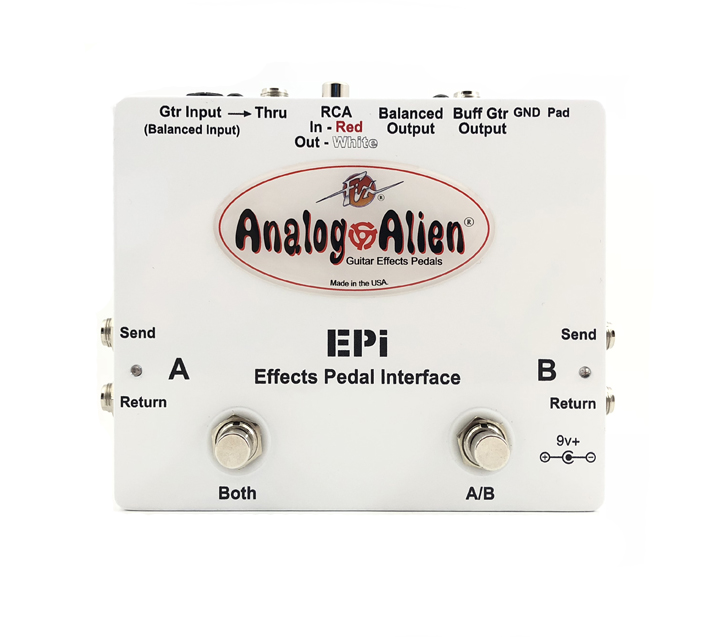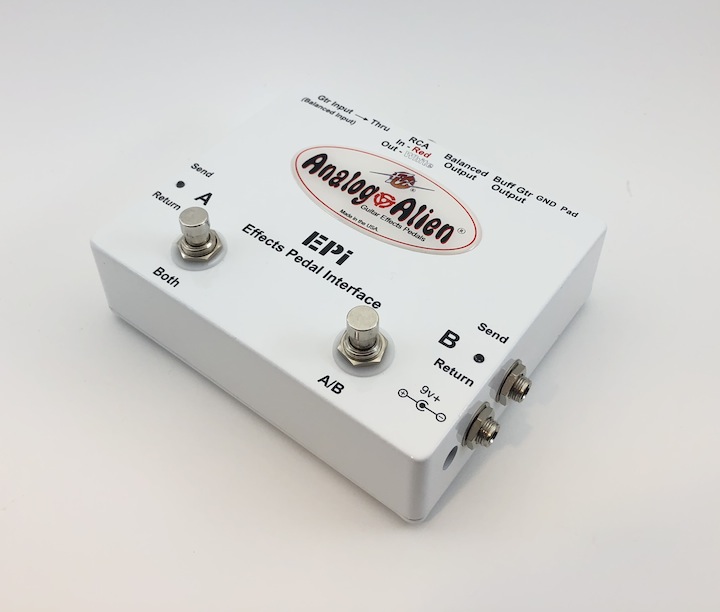EPi (Effects Pedal Interface):
• Use guitar effects pedals with line-level devices such as drum machines, mixing consoles, 500 series processors, recording interfaces, etc.
• Dual effects send/return loops with separate foot-switches
• Automatically adjusts impedance and voltage levels for the highest possible fidelity
• Outputs include balanced XLR, buffered 1/4″, and RCA -10dBu
• Balanced 1/4″ input can accept instrument-level signal as well as line-level signals
• Guitar thru-output for connecting to an amplifier or guitar tuner
• Can be used to switch between two different pedal-boards (or blend them)
• Can also be used as an A-B-Y box, a direct box, a re-amping device, or as a four-way splitter
EPI Sound Clips:
Use it as a DI (Direct Box).
Connect your guitar or bass to the instrument input on the Analog Alien EPi, then connect the thru jack to your amplifier. You can use the balanced XLR output to connect directly to a mixing console or recording interface.
Re-amp tracks from your DAW.
Route a dry guitar or bass track to a balanced output on your audio interface, and connect it to the EPi’s balanced input. Connect the buffered guitar output to your amplifier of choice, then mic it up. You’re ready to re-amp tracks from your DAW.
Record with your effects pedals.
You can use the Analog Alien EPi to optimize your signal level for any device. Plug your guitar into your pedal chain, then run the chain into the main input on the EPi, taking advantage of its magical input stage. Choose to run your guitar into the EPi, with your pedals arranged in the two loops, and switch between them. Either way, you’ll be able to send a balanced XLR output to pro-level recording devices, or out of the RCA output for -10dBu consumer devices. The RCA output can also be sent directly into your smartphone.
Bypass an entire pedal-board.
Connect your pedal-board to the EPi [via the send and return jacks] for either effects loop (leave the other loop unconnected). Use the A/B switch to switch between the loop your pedal-board is in, and the unconnected loop. This effectively gives you a bypass switch for an entire pedal-board.
Play through up to four amps simultaneously.
Connect your guitar or bass to the EPi, and send its thru jack to your first amplifier. Use the send jacks from loop A and loop B to connect to amps two and three. Then use the buffered output to connect to your fourth amplifier. The coolest thing about this setup is that you can use the A/B switch to toggle between two of the amps, and the Both switch to engage both of them – simultaneously.
Switch between two different pedal-boards.
If you rely on lots of pedals to create your signature tones, why not use the Analog Alien EPi to switch between two different pedal-boards? Simply connect each pedal-board to the send and return loops, and switch between them with the A/B switch. Or kick on the Both switch, combining two separate processing chains into one for a massive wall of sound.
How to use the EPi:
A&B insertion points – the EPi has two separate insertion points that are independent of each other – A&B. These insertion points enable you to set up two separate signal chains, while switching between either of them. Feel free to have them both on at that same time. You can blend both signal paths, independently from each other, and then combine them at the balanced XLR, buffered 1/4″ or RCA -10dBu outputs.
Unique input circuit – you can also plug the output of your stomp box directly into the input of the EPi, taking advantage of its unique input circuit. Your distortion and overdrive pedals will take on a whole new sonic dimension when you record them with the EPi.
DAW/mixing console – the input of the EPi can also accept a direct signal from the output of your DAW or mixing console. You can send a pre-recorded track to any effects pedal, and then re-record the signal back into your DAW. If you ever wondered what your vocal or snare drum tracks would sound like through your favorite guitar pedal, now you’ll know.
Multiple uses – the EPi can also be used as an A-B box (with both A&B on – simultaneously), a Direct Box (DI) or a Re-Amp Box. In addition, you can split your guitar’s signal and send it out to 4 separate amps, with 4 separate effects – all at the same time!
A/B insertion jacks – in live stage situations, you can hook up two separate pedal boards to the A/B insertion jacks and have each board on, independently. Or, have both on at the same time while simultaneously sending your effected signal to the house PA and your guitar amp!







Reviews
There are no reviews yet.